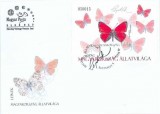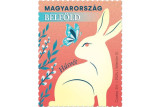
1. MAGYAR - MAGYARORSZÁG ÁLLATVILÁGA: LEPKÉK, PILLANGÓK - BÉLYEGBLOKK - Bélyeg rendelési kód: F2011/019
2. ENGLISH - FAUNA OF HUNGARY: MOTHS AND BUTTERFLIES - STAMP - Order code of the stamp: F2011/019
3. GERMAN - UNGARNS TIERWELT: FALTER, SCHMETTERLINGE - STAMP - Die Bestellnummer Der Marke: F2011/019
1. MAGYAR - MAGYARORSZÁG ÁLLATVILÁGA: LEPKÉK, PILLANGÓK - BÉLYEGBLOKK
A Magyar Posta hagyományai szerint évente bélyegblokk és bélyegsorozat formájában mutatja be Magyarország jellegzetes állatvilágát. A 2011. évi újdonságokon lepkék láthatók.
A pikkelyes szárnyú rovarok, vagyis a lepkék (Lepidoptera), az ízeltlábúak törzsében feltételezés szerint a rovarok osztályának az egyik utolsóként kifejlődött rendje. Eddig mintegy 150.000 lepkefajt írtak le; a Kárpátmedencében 3500 faj jelenlétét mutatták ki. A lepkék rendjébe sorolt élőlényeknek a magyar nyelvben több általános megnevezése is előfordul: moly, lepke, pille és pillangó.
A Magyarországon mintegy 40 lepkecsaládot képviselő faj legtöbbje parányi és törékeny, akad köztük nagy és kövér, és többnyire éjszaka repül. Ezeket a közbeszéd molynak vagy pillének nevezi. A lepke és a pillangó szavainkat inkább a nappal repülő színpompás és kecses fajokra tartja fent.
De amíg a szak-nyelv a moly és a pille szavakat fenntartja a parányi méretű fajokra, addig a lepke elnevezést sokkal szélesebb körben alkalmazza. A pillangó viszont kizárólagosan egyetlen családot jelölhet, amit hazánkban csak négy faj képvisel, amelyek a forró égöv alatt élő csodálatos rokonaikhoz képest bár elegáns, mégis szerény megjelenésűek. (Forrás: Bálint Zsolt szakértő írása)
A bélyegsorozat címletein fehér háttérben, névérték szerinti sorrendben látható a Duna ártereire jellemző Magyar színjátszólepke (Apatura metis), az erdős pusztáinkról már eltűnt Magyar sakktáblalepke (Melanargia suwarovius), a kertjeinkben megritkult Közönséges medvelepke (Arctia caja) és a tocsogós mezőségek környékén még gyakori Törpeszender (Proserpinus proserpina).
A sorszámozott blokk keretrajzán és bélyegképén a pompázatos és láprétjeinken mindenütt előforduló Nagy tűzlepke (Lycaena dispar) sajátos grafikai ritmust alkotó, finomrajzolatú és eredeti színben pompázó példányai ismétlődnek. Az alkalmi boríték és bélyegző grafikáján szintén lepke motívumok ismétlődnek.
Forrás: Magyar Posta
2. ENGLISH - FAUNA OF HUNGARY: MOTHS AND BUTTERFLIES - STAMP
In keeping with its traditions, Magyar Posta presents the characteristic fauna of Hungary each year on a stamp block and set of stamps. The new 2011 stamps depict butterflies and moths.
Insects with scale-covered wings (Lepidoptera) include moths and butterflies, which are thought to be the last order to have evolved among arthropods. To date about 150,000 species of moths have been identified, and 3,500 are known to have occurred in the Carpathian Basin. Insects belonging to the Lepidoptera order are commonly described in Hungarian by a number of words, which can be summarised in English as moth and butterfly. Most of the species representing 40 moth families living in Hungary are small and fragile, but there are some which are large and fat, and they usually fly at night. The ones that are nocturnal are called moths in everyday speech. The word butterfly is mainly used for the splendid dainty species with beautiful coloration, which are on the wing during the day. All butterflies belong to one family only, which is represented by 4 species in Hungary. These, compared to their wonderful relatives living in the tropics, are elegant but modest in appearance. (Source: written by the expert Zsolt Bálint)
The stamps of the set show, in order of ascending face value, on a white background Freyer’s Purple Emperor (Apatura metis), which is characteristic in the Danube’s catchment area, Esper’s Marbled White (Melanargia russiae), which used to live in our forest steppe areas but has now disappeared, Garden Tiger Moth (Arctia caja), now a less frequent visitor to our gardens, and the Willowherb Hawk-moth (Proserpinus proserpina), still quite common in wet meadows. In the border and the stamp design of the numbered block the splendid Large Copper with its original coloration is repeated in a delicate drawing, imparting a special rhythm. This butterfly occurs in marshland in Hungarian areas. Butterfly motifs are likewise repeated in the design of the first day cover and the special postmark.
3. GERMAN - UNGARNS TIERWELT: FALTER, SCHMETTERLINGE - STAMP
In keeping with its traditions, Hungary Post presents the characteristic fauna of Hungary each year on a stamp block and set of stamps. The new 2011 stamps depict butterflies and moths.
Insects with scale-covered wings (Lepidoptera) include moths and butterflies, which are thought to be the last order to have evolved among arthropods. To date about 150,000 species of moths have been identified, and 3,500 are known to have occurred in the Carpathian Basin. Insects belonging to the Lepidoptera order are commonly described in Hungarian by a number of words, which can be summarised in English as moth and butterfly. Most of the species representing 40 moth families living in Hungary are small and fragile, but there are some which are large and fat, and they usually fly at night. The ones that are nocturnal are called moths in everyday speech. The word butterfly is mainly used for the splendid dainty species with beautiful coloration, which are on the wing during the day. All butterflies belong to one family only, which is represented by 4 species in Hungary. These, compared to their wonderful relatives living in the tropics, are elegant but modest in appearance. (Source: written by the expert Zsolt Bálint)
The stamps of the set show, in order of ascending face value, on a white background Freyer’s Purple Emperor (Apatura metis), which is characteristic in the Danube’s catchment area, Esper’s Marbled White (Melanargia russiae), which used to live in our forest steppe areas but has now disappeared, Garden Tiger Moth (Arctia caja), now a less frequent visitor to our gardens, and the Willowherb Hawk-moth (Proserpinus proserpina), still quite common in wet meadows. In the border and the stamp design of the numbered block the splendid Large Copper with its original coloration is repeated in a delicate drawing, imparting a special rhythm. This butterfly occurs in marshland in Hungarian areas. Butterfly motifs are likewise repeated in the design of the first day cover and the special postmark.


